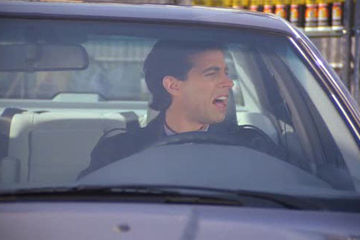What I’ve Learned:
“Quantum entanglement: It may be spooky — but at least it won’t stink up your ride.”
At first, quantum entanglement sounds a little complicated. Entanglement occurs when two elementary particles — electrons or photons, for instance — interact in a way that links some property of those particles together. So if you measure the spin, say, of one electron, you also know the spin of the second, no matter where in the universe that other electron has gotten itself off to. It could still be in the same test chamber. It could be in Hoboken, New Jersey. It doesn’t matter.
There’s a way of thinking about this that makes quantum entanglement seem much simpler. Like all good scientific analogies, it involves Seinfeld.
Imagine the two electrons ride together to the laboratory in Jerry’s car. Specifically, the car parked by that valet who had the really terrible B.O. The kind of funk that couldn’t be cleaned out, and attached itself to everything that came near it — like Jerry’s jacket, or Elaine’s hair.
In this scenario, you clearly only need to measure one electron. If the first particle stinks, and you know they were both in the B.O.-mobile, then the second particle is going to stink, too. Maybe the second particle took a shower. Or sprayed on Old Spice. Or flew to Paris to bathe in perfume. It doesn’t matter. You don’t escape the B.O. car stench.
The key here is that the fates of the electrons were sealed at the time they interacted. If that’s the case, the distance between the two when they’re measured isn’t relevant — they were funkified together, back on the ride to work. This idea is called a “hidden variable” theory, and it makes quantum entanglement much, much easier to understand.
It’s also completely wrong. Which is a shame, because I’ve always thought science could use more Julia Louis-Dreyfus.
Using large-scale experiments and lots of complicated Greek-letter math, physicists have proven (or nearly proven, depending on who you ask) that hidden variables are not involved in quantum entanglement. For either particle, it’s impossible to know or predict the entangled property before it’s measured. But once it’s known, the corresponding property of the other particle somehow “knows” about this measurement, and locks into place. This happens immediately — or at least, thousands of times faster than the speed of light, which is theoretically impossible.
Or was, until bizarro quantum entanglement concepts were first debated back in the ’30s by scientists like Erwin Schrodinger, Boris Podolsky, Nathan Rosen and Albert Einstein.
(Incidentally, Einstein in particular rejected the idea of quantum entanglement, calling it “spooky action at a distance”.
I’m no particle physicist, but any time you describe a theory the same way you would a guy who touches himself while he watches you across the subway car, you’re probably not a fan.)
Besides being wicked weird, quantum entanglement is a hot topic in physics these days. Entanglement is the key to quantum computing, may unlock virtually unbreakable cryptography, could be the secret to photosynthesis and might even be responsible for why time flows in one direction.
Not bad for a phenomenon that’s spookier than subway creeps, and more confusing than permanent automotive armpit stank.



